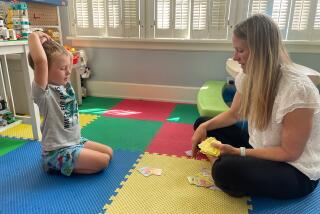‘90s FAMILY : Teaching Kids to Think on Their Own
- Share via
Lessons about violence start early. When kids complain, “Mommy, he hit me,” parents may reply with a knee-jerk, “Don’t hit him back, go tell the teacher.” Or maybe, “Hit him back, otherwise he’ll keep hitting you.”
The problem, according to one researcher, is that both answers encourage kids to stop thinking. On a larger scale, it contributes to a generation of kids who don’t know how to think because they’ve been told for too long what to think, said clinical psychologist Myrna Shure of Hahnemann University in Philadelphia.
“Kids who can think of more than one way to solve a problem are less likely to fail,” she said. “They’re less likely to feel frustrated, aggressive, to experience a sense of powerlessness or be socially withdrawn.”
Those are the very feelings that lead to the major social problems of the day--violence, substance abuse, teen pregnancy, depression. “Telling kids not to do something, if anything, makes them want to do it more,” Shure said.
In her book, “Raising a Thinking Child” (Henry Holt, 1994), Shure describes how parents can guide children toward solving their own problems by using dialogues about their conflicts. The techniques work best with 4- to 7-year-olds.
Parents can build a base with very young children by using games to ensure they understand words like “different,” “before,” “after” and “not.”
Then, when children are hitting, for instance, parents can ascertain the nature of the problem by asking a non-threatening question such as: “What happened before he hit you?” Next, they can ask each child how he felt when hit, or when he hit someone. Then, they ask what happened next. Last, they ask, “Can you think of a different way to solve this problem?”
“It may not work the first time, or the first 10 times,” Shure said. “Remember the goal is not always to solve a problem now. It’s to set the stage for a style of thinking so that the child can take over.”
If they say, “I don’t know,” parents can say playfully, “I bet you can,” or “I know if you think really hard, you can come up with an idea.”
When they do, parents should say, “Good thinking,” to reinforce that they are thinking, not what they are thinking.
One mother said as soon as she brought her second son home from the hospital, his older brother started grabbing his toys. “I was getting so tired of telling him to stop. I thought, ‘There has to be a better way.’ ”
After learning the techniques, she said, “I started saying, ‘How do you feel in nursery school when someone takes something away from you?’ ”
“He said, ‘Bad, Mom.’
“I said, ‘That’s how Phillip feels. What can we do?’
“He said, ‘I guess we can give him another toy.’ I was really impressed.”
Not every kid will respond, but Shure said her longitudinal research shows that this kind of training produces thinking and feeling kids who are less likely to hurt other people. She said she has achieved results with kids from all social and economic backgrounds, kids with Attention Deficit Disorder, shy children and normal kids. Her program is being used in about 50 schools across the country.
“Children can learn solutions and consequences at 4,” she said. “But the earlier you are training them to think this way, the faster the impact on either reducing or preventing behavior problems that later predict more serious problems such as violence and substance abuse.”
More to Read
Sign up for Essential California
The most important California stories and recommendations in your inbox every morning.
You may occasionally receive promotional content from the Los Angeles Times.













